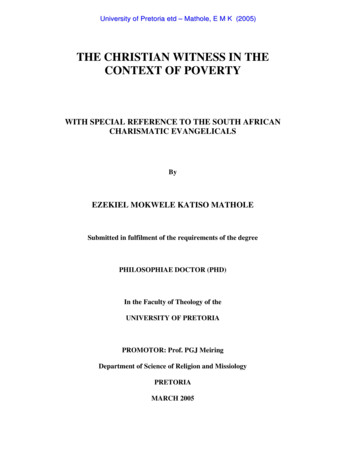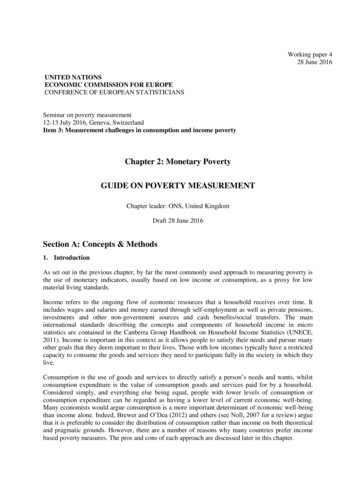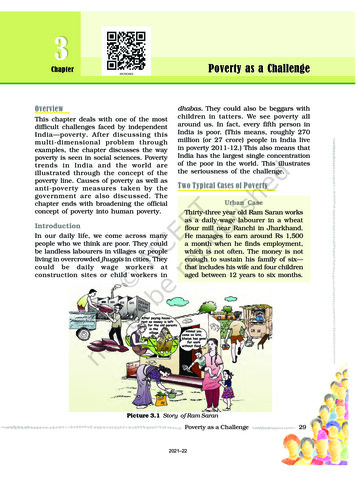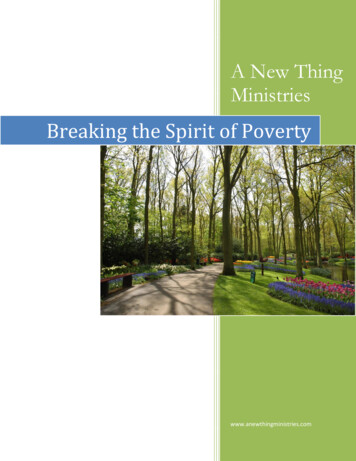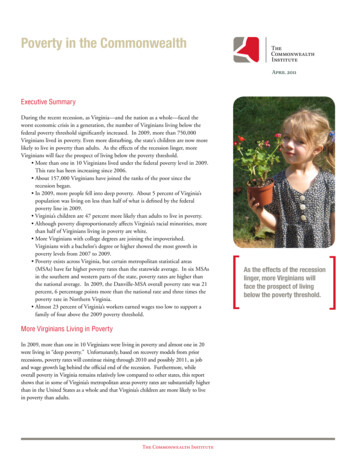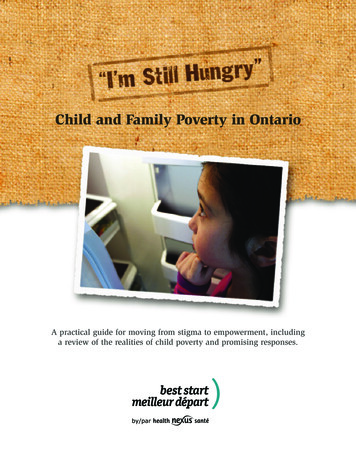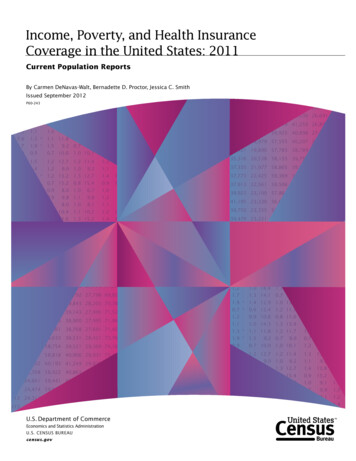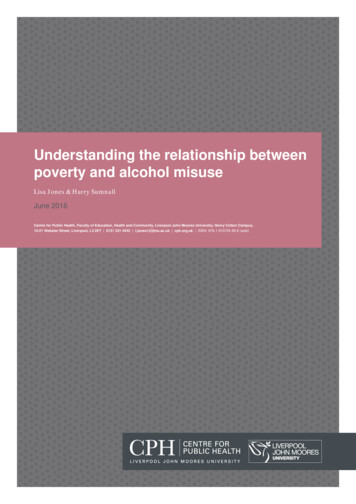
Transcription
Understanding the relationship between poverty and alcohol misuseUnderstanding the relationship betweenpoverty and alcohol misuseLisa Jones & Harry SumnallJune 2016Centre for Public Health, Faculty of Education, Health and Community, Liverpool John Moores University, Henry Cotton Campus,15-21 Webster Street, Liverpool, L3 2ET 0151 231 4542 l.jones1@ljmu.ac.uk cph.org.uk ISBN: 978-1-910725-69-6 (web)1
Table of ContentsAbout this ew of the relationship between poverty and problem alcohol use94Review of effectiveness and cost-effectiveness for policies and interventions185Conclusions236References25Appendix 1. Detailed methods36Appendix 2. Evidence tables38
Understanding the relationship between poverty and alcohol misuseAbout this reportThis rapid review of the evidence on poverty and alcohol misuse was commissioned by the Joseph RowntreeFoundation as part of their programme to develop Anti-Poverty Strategies for the UK. The purpose of the rapid reviewis to provide an evidence base that the Joseph Rowntree Foundation can use in developing their Anti-Poverty Strategies,enabling them to decide how to address alcohol misuse within the Strategies.The findings of the rapid review are presented across five chapters.Chapter 1 presents an introduction to the issues around alcohol consumption, summarising existing knowledgeon the risks and benefits of alcohol consumption to health, to others and related issues of stigma andmarginalisation. It also identifies the definitions used in this report for problem alcohol use and presentsprevalence figures on problem alcohol use in the UK.Chapter 2 provides a summary of the methods used to collate the evidence used in the rapid review. More detailon the methods is also provided in Appendix 1.Chapter 3 presents the findings from a review of the correlations between poverty and problem alcohol use.This chapter also summarises the research evidence for the mechanisms and pathways that may linkpoverty and problem alcohol use.Chapter 4 presents a summary of the evidence on the effectiveness and cost-effectiveness for policies andinterventions targeting problem alcohol use.Chapter 5 brings together and discusses the findings from the two review elements and attempts to draw outimplications for research and policy.AcknowledgementsWe are very grateful to our peer reviewers, Dr James Nicholls (Research Manager, Alcohol Research UK andHonorary Senior Lecturer, London School of Hygiene and Tropical Medicine) and Professor Penny Cook (School ofHealth Sciences, University of Salford), for their helpful and insightful comments on draft versions of this rapid review.We would also like to thank Dr John Holmes (School of Health and Related Research, University of Sheffield) for hisuseful comments on Chapter 4.4
Understanding the relationship between poverty and alcohol misuse1. IntroductionAlcohol use is one of the top five leading risk factors for death and loss of health in the UK (Murray et al., 2013).In addition to the well-established relationship between alcohol and the development of a number of different diseaseand health problems, its consumption also has social and economic consequences both to the individual and society.Most adults in the UK consume alcohol (Health and Social Care Information Centre, 2015) and its use both influences,and is influenced by, social and cultural norms.1.1 Risks and benefits of alcohol consumption?Observational studies suggest that light to moderate levels of alcohol consumption are associated with cardiovascularbenefits (Roerecke and Rehm, 2012). However, researchers have argued that most of the physiological mechanisms thatmay explain alcohol’s protective effects only apply to an overall low level of consumption and patterns of regular drinkingthat do not vary (Rehm et al., 2003). For drinkers that include any heavy or binge drinking occasions in their overallvolume of drinking, light to moderate drinking is unlikely to have any protective effect. A further challenge to the conceptof protective effects of alcohol on cardiovascular health have arisen through analysis using a genetic approach (Holmeset al., 2014c). The protective effects of drinking may also in part be explained by the association between drinking habitsand social characteristics. Light to moderate alcohol consumption has been found to be an indicator of ‘optimal’ socialstatus, such as being in good cardiovascular health (Hansel et al., 2010), and studies also show that abstainers aremore likely to have unhealthy lifestyles and poorer psychosocial factors than moderate drinkers (Fekjær, 2013). Alcoholconsumption is also a cause of some types of cancer and research shows there is no level of consumption that can beconsidered ‘safe’ from the risk of cancer (World Cancer Research Fund/American Institute for Cancer Research, 2007).Complications arise in identifying risky patterns of drinking because of methodological issues encountered in theliterature and particular problems with distinguishing between single occasion binge drinking and chronic heavy drinking(Gmel et al., 2011). This has implications for how messages about harms and benefits are conveyed to, and viewed by,a general audience. Perceptions and beliefs about the risks associated with alcohol consumption are shaped throughpublic and policy debates and Holloway et al. (2008) have argued that in England these have been “overly biasedtowards problem drinking in public spaces”. This may consequently lead people to regard their own risky drinkingpractices as unremarkable (Valentine et al., 2007).1.2 Effects of problem alcohol use on othersThe impact of alcohol on others is extensive, ranging from minor inconvenience to more severe impacts such as alcoholrelated road traffic deaths and interpersonal violence (Giesbrecht et al., 2010, Laslett et al., 2010). Taking a UK focus, areport on the impact of the drinking of others in Scotland documented the wide range of harms experienced among thepopulation both in public and private settings (Hope et al., 2013). This survey found that a greater proportion of those inlower social classes reported problems with friends and neighbours, were harassed at a party or in some other privatesetting, had family problems or marriage difficulties and were harmed physically. Problem alcohol use can disrupt familystructures and functions (Velleman and Templeton, 2007). Alcohol use is a contributory factor in domestic violence (WorldHealth Organization, 2006), and a recent meta-analysis found clear evidence that alcohol use and domestic violence areassociated for both males and females (Foran and O’Leary, 2008). Parenting capacity is also affected by alcohol useand children living with parental alcohol misuse may experience neglect or abuse (Cleaver et al., 2011). Internationally,studies have reported a rate of involvement of alcohol in 13-70% of substantiated child protection cases, with oneAustralian study showing that parental alcohol misuse is related to more intensive child protection outcomes, such asprogress to protective interventions and court orders (Laslett et al., 2012).1.3 Stigma and marginalisationHow people respond to others’ alcohol use exacerbates harm (World Health Organization, 2007). Alcohol dependence isa highly stigmatized health condition and as Room (2005) argues, “the use of alcohol [and drugs] is strongly moralized,and those transgressing moral norms are subject to stigma and social marginalization”. The relationship between alcohol1Social grade C2DE classified according to the occupation of the chief income earner (C2 skilled)5
Understanding the relationship between poverty and alcohol misusedependence and stigma particularly manifests itself through the perception that those affected have personal controlover their illness (Livingston et al., 2011). The WHO Expert Committee on Problems Related to Alcohol Consumptionnoted that “there a clear tendency for many cultures to marginalize particularly those who are both poor and habituallyintoxicated, and that there are many pathways by which poverty can enable or exacerbate the stigmatization ofintoxication” (World Health Organization, 2007). People who are poor or living in poverty may be less able to avoid orbuffer the social consequences of their drinking unlike their more affluent counterparts. Police surveillance of ‘anti-socialbehaviour’ such as public drunkenness may also be heightened in poor communities. Thus in affluent societies, the WHOExpert Committee (World Health Organization, 2007) highlighted “that there is a very strong overlap between the mostmarginalized population and those defined as having serious alcohol problems”.1.4 Definitions of problem alcohol useVarious terms are used to refer to alcohol consumption that poses risk, and operational definitions vary internationally.For the purposes of this rapid review we have used the following definitions based on Whitlock et al. (2004): Risky/Hazardous drinkers: those exceeding daily, weekly, or per occasion thresholds; Harmful drinkers: those that exhibit physical, social, or psychological harm, without meeting criteria for dependence; Alcohol dependent drinkers: those that continue to use alcohol despite significant negative physical, psychologicaland social consequences.Screening questionnaires used to detect problem alcohol use include the Alcohol Use Disorders Identification Test(AUDIT), the Fast Alcohol Screening Test (FAST) and CAGE. For assessing the severity of dependence on alcohol, theSeverity of Alcohol Dependence Questionnaire (SADQ) may be used in clinical settings to subdivide alcohol dependentdrinkers into categories of mild, moderate and severe. People with mild dependence (e.g. SADQ score 15) usually donot need assisted alcohol withdrawal; people with moderate dependence (e.g. SADQ score 15–30) usually need assistedalcohol withdrawal, typically managed in the community; and people with severe alcohol dependence (e.g. SADQ score 30) need assisted alcohol withdrawal, typically in an inpatient/residential setting.In the UK, this is above the government’s recommended daily drinking limits of 4 or more units a day for men and 3 or more units a dayfor women.3Based on four clinical questions focusing on Cutting down, Annoyance by criticism, Guilty feeling, and Eye-openers; hence theacronym CAGE.4Results from the 2014 Adult Psychiatric Morbidity Survey (also known as the National Study of Health and Wellbeing) are expected tobe available in 2016.26
Understanding the relationship between poverty and alcohol misuse1.5 Prevalence of problem alcohol useNational household surveys provide the most reliable estimates of the prevalence of problem alcohol use in thepopulation. However, surveys do not commonly include assessment of harmful drinking or dependence. We are thereforecurrently reliant on data from the 2007 Psychiatric Morbidity Survey of adults in England (Fuller et al., 2007). This surveyused the AUDIT to assess hazardous and harmful drinking, and SADQ to assess symptoms of dependence. Accordingto this survey, almost a quarter (24%) of adults were hazardous drinkers and 4% were also harmful drinkers. Hazardousdrinking was most common in younger age groups among both men and women and became less likely with increasingage. For example, of men aged 25 and 34 years, 46% were classed as hazardous drinkers and 12% were also harmfuldrinkers. Around 6% of adults in England had experienced symptoms of alcohol dependence ranging from mild to severedependence. Alcohol dependence varied with age with younger men and women more likely to show some degree ofdependence; however, cases of severe dependence are most commonly found in adults aged 35 years and older.What is the extent of problem alcohol use among people living in povertyAs there are no figures available to determine what proportion of the estimated 13 million adults who live inpoverty overlap with the categories of problem drinkers the extent of the problem is unknown.According to Public Health England (2014), around 9 million adults in England are hazardous drinkerswith 2.2 million also harmful drinkers. An estimated 1.6 million adults in England may have some degreeof alcohol dependence. Of these, around 250,000 may be moderately or severely dependent on alcohol.According to the 2007 Psychiatric Morbidity Survey, 8.5% of men and 3.0% of women in the lowest incomequintile had experienced any symptoms of alcohol dependence in the last 6 months; 2.5% and 0.1%,respectively, had experienced moderate or severe symptoms of dependence that would indicate a needfor assisted alcohol withdrawal.5After housing costs. Taken from Households Below Average Income, Department for Work and Pensions, June attachment 994-95to-2013-14.pdf7
Understanding the relationship between poverty and alcohol misuse2. MethodsThis work was based on a rapid review of the existing literature in order to better understand: The hypothesised pathways and mechanisms linking poverty and deprivation to problem alcohol use; and The extent and strength of the evidence for the effectiveness and cost-effectiveness of policy and practiceinterventions that might impact on the pathways linking poverty and problematic alcohol use.The research proceeded in accordance with JRF’s own definition of poverty (when a person’s resources (mainlytheir material resources) are not sufficient to meet their minimum needs (including social participation)). Howeverwe considered relevant, studies examining poverty and deprivation through relevant associated concepts such associoeconomic status (SES), economic position and material deprivation. Poverty is a complex construct (Krieger, 2001),which can be difficult to conceptualise and measure (Hauser and Carr, 1995, Walker et al., 2010) and empirical studieshave tended to use other indicators such as measures of the social and economic position of individuals and groups.SES has been defined as an individual’s or group’s social and economic position in relation to others, typically measuredacross the domains of income, educational attainment and occupational grade (Kawachi et al., 2002). According to theAmerican Psychological Association (2007) the fundamental conceptualisation of SES involves access to resources,including goods and services (e.g. education, healthcare) as well as access to information and social resources. SEShas often been treated as a unified concept, but Cutler et al. (2008) argue that this is not correct noting that “SESconsists of not one but many dimensions, which relate to health in diverse ways”. Krieger (2001) notes that the term,SES, “arbitrarily privileges ‘status’ over material resources as the key determinant of socioeconomic position”. Thusresource-based measures of social and economic position, which refer to material and social resources and assets, maybe more interchangeable with terms used to describe inadequate resources such as poverty and deprivation.Chapter 3 in this report (Review of the relationship between poverty and problem alcohol use) examines the associationbetween poverty and alcohol use using studies that have examined problem alcohol use as the exposure and povertyas the outcome of interest, and vice versa. The research primarily focused on work undertaken in the UK, but wasbroadened to include studies conducted in other developed countries and published in English where relevant. Asevidence was gathered on the pathways and mechanisms linking poverty and problem alcohol use, qualitative evidencethat provides further context to the quantitative findings is highlighted.The purpose of the work was to enable the Joseph Rowntree Foundation and other stakeholders to better understandtargets of action for potential policy and practice interventions, and so Chapter 4 of the report (Review of effectivenessand cost-effectiveness for policies and interventions) reviews evidence for the effectiveness and cost-effectivenessof approaches that might impact on the pathways identified. This was achieved through a rapid review of high qualitysystematic reviews and the conceptual framework developed in the first stage of research guided the evidence synthesis,and the development of policy and practice recommendations.Further details of the methods used in compiling the evidence for this report is provided in Appendix 1.8
Understanding the relationship between poverty and alcohol misuse3. Review of the relationship between poverty and problem alcohol use3.1 IntroductionAlcohol-related problems affect individuals and groups across social and economic strata but there is a growing literatureon how social and economic standing relate to alcohol-related harm (Jones et al., 2015). In this section we explore therelationship between poverty and problem alcohol use in an attempt to understand the causal links and examine the UKevidence for how much problem alcohol use is both a response to, and a driver of, poverty. Establishing the temporalrelationship is crucial and there must be clear evidence that the cause precedes the effect, whether this be povertyand problem alcohol use and vice versa. In Section 3.3 we draw on analyses of large UK cohort studies that shedsome light on the temporal relationship between socioeconomic position over the lifecourse and problem alcohol use inmidlife. However, first we consider what is known about the association between deprivation and problem alcohol use toestablish the need to explore the relationship further.Studies conducted internationally show a clear and persistent gradient in the risks of alcohol-related death by SES, suchthat people with lower income, education or occupational status are much more likely to die or suffer from a diseaserelated to their alcohol use (Makela, 1999, Romelsjo and Lundberg, 1996, van Oers et al., 1999). For UK men andwomen, analysis has shown that workers in routine occupations have an alcohol-related death rate, 3.5 and 5.7 timesgreater, respectively, than those in the highest occupational positions (Siegler et al., 2011). However, when we examinethe association between socioeconomic disadvantage and alcohol consumption a complex relationship emerges.Studies have found that people in deprived neighbourhoods may be more likely to both abstain from alcohol than thosein more affluent neighbourhoods (Kuipers et al., 2013, Galea et al., 2007, Chuang et al., 2007) and more commonlyadopt heavier patterns of consumption, such as binge drinking (Matheson et al., 2011, Cerdá et al., 2010, Stimpsonet al., 2007, Fauth et al., 2004, Mulia and Karriker-Jaffe, 2012). Household surveys conducted in the UK also reflectthis a complex relationship, with self-reported alcohol consumption being broadly similar between low and high SESpopulations, but with a higher prevalence of consumption among those of higher SES (Office for National Statistics,2013, Fuller, 2013). A recent study based on data from the Welsh Health Survey 2003/2004-2007 found that while excessconsumption was more common among people living in less deprived areas, a higher risk of binge drinking was seenamong residents of deprived neighbourhoods (Fone et al., 2013). Using a bespoke national alcohol survey to explorewhy harms disproportionately affect people living in deprived communities, research has found that people living in themost deprived communities may be more likely than those in affluent communities to adopt risky drinking patterns (Joneset al., 2015, Bellis et al., 2015).9
Understanding the relationship between poverty and alcohol misuse3.2 Conceptual frameworkAt the outset of the review a conceptual framework was developed to outline assumptions about the pathways andmechanisms linking poverty and deprivation to problem alcohol use and its resulting harms. The conceptual frameworkwas updated as the review progressed and is shown in Figure 1. Three hypotheses about the causal direction of anyassociation between socioeconomic position and problem alcohol use outlined by Makela (1999) were influential.The social causation hypothesis states that SES affects high-risk drinking, whereas the social selection or socialdrift hypothesis suggests that high-risk drinking affects SES. That is, harmful use of alcohol has socioeconomicconsequences for individuals, including loss of earnings, unemployment, family disruption or stigmatization (Schmidt etal., 2010). People experiencing poverty or deprivation to start with may suffer further disadvantage as a result of theirharmful use of alcohol, and among those not currently affected, the socioeconomic consequences may give rise to orintensify downwards social mobility (Selin, 2005). Furthermore, Makela (1999) also alludes to additional “third” factorsthat may affect both SES and drinking (e.g. ethnicity).Social CausationSocial DriftDeterminantsChildhood socioeconomic positionAdult socioeconomic position Education Occupation Employment Status Household IncomeMaterialdeprivationProblemalcohol useAcute/chronicstressNeighbourhood deprivation Income Education Employment Health Housing Living environment CrimeSocial and economicconsequences Family Breakdown Loss of earnings Financial problems aritalStatusRiskbehavioursThird FactorsFigure 1. Conceptual framework; including example third factorsThe framework directs attention to the social causation hypothesis that acute and chronic stress generated by povertyand deprivation increase the likelihood of problem alcohol use. In presenting socioeconomic position and neighbourhooddeprivation as the likely determinants of stress we acknowledge that there are large gaps in the evidence in terms of howand why these mechanisms act in the development of problem alcohol use. We also acknowledge that the proposedmechanisms may not be applicable across all poverty and deprivation strata, and therefore may only be relevant toparticular groups. The social drift hypothesis is also characterised in the model; problem alcohol use is thought tosubsequently generate further social and economic consequences for the individual, which may impact further on theirsocial and economic position (represented by the dashed arrow).10
Understanding the relationship between poverty and alcohol misuse3.3 Temporal relationship between poverty and problem alcohol useThe findings from longitudinal studies that shed some light on the temporal relationship between socioeconomicposition over the lifecourse and problem alcohol use in midlife are discussed below and summarised in the context ofhypothesised mechanisms linking poverty and problem alcohol use.3.3.1 Socioeconomic status over the lifecourseTwo studies (Jefferis et al., 2007, Caldwell et al., 2008) examined findings from the 1958 British Birth Cohort Study anda further two studies (Batty et al., 2008, Batty et al., 2012), the West of Scotland Twenty-07 Study. The 1958 British BirthCohort study is ongoing and follows the lives of 17,000 people born in England, Scotland and Wales during a singleweek in March, 1958. Surveys have so far been conducted in childhood at age 7, 11, and 16 years and in adulthood atage 23, 33, 42 45 and 55 years. Jefferis et al. (2007) used data from the adult surveys at age 23, 33, and 42 years toinvestigate associations between social position (based on level of education and social class) and ‘binge’ drinking. Theyfound that across all ages, men with a low social position reported binge drinking more often than those with a highersocial position; for example, at age 23, men with no qualifications had 1.63 times greater odds of binge drinking thanthose with higher qualifications. A different relationship was found amongst women. At age 23, women with a low socialposition were less likely to binge drink than those with a higher social position, but at older ages they became morelikely to binge drink. Caldwell et al. (2008) analysed alcohol consumption data from the adult survey at age 45, duringwhich participants were administered the Alcohol Use Disorders Identification Test (AUDIT) to identify heavy, problem,and binge drinkers. Participants with indicators of low SES across childhood and adulthood were at an increased risk ofreporting binge and problem drinking. A less clear relationship was noted with heavy consumption. The authors reportedthat each additional report indicative of low SES during childhood was associated with a 7% increase in risk for midlifeproblem drinking. Therefore, participants with low SES at all three childhood surveys had a 21% increase in risk of midlifeproblem drinking. The authors also examined cumulative disadvantage over the life course and this was found to be thestrongest predictor of drinking patterns in the study. They found that only participants who reported disadvantage acrossboth adulthood and childhood (‘intergenerational disadvantage’) had an increased risk of midlife problem drinking. Non-,occasional- and moderate-binge drinking was predicted by disadvantage during childhood alone, whilst disadvantagein adulthood alone was not associated with an increased risk for any of the drinking patterns under investigation.Caldwell et al. (2008) suggest that alongside factors such as cultural differences and physical health, “it is feasible thatsocioeconomic disadvantage polarises drinking behaviour, causing some people to abstain and others to drink heavily”.The West of Scotland Twenty-07 Study followed three cohorts of people living in and around Glasgow initially recruited atages 15, 35 and 55 years and followed for 20 years. Problem alcohol use was identified using the CAGE questionnaire.Using data from men in the oldest age group, Batty et al. (2008) found that indicators of deprivation in both early lifeand adulthood, and their accumulation over the life course (based on a lifetime score for socioeconomic adversity) wereassociated with an increased risk of midlife problem alcohol use. However in this analysis, deprivation in adulthoodwas more strongly associated with problem drinking than deprivation in early life. Additionally, they found that materialsocioeconomic indicators in adulthood (including car ownership, housing tenure) were generally associated morestrongly with problem drinking than other socioeconomic factors (e.g. education, income and occupational social class).Following on from the 2008 study, Batty et al. (2012) based their analyses on men and women recruited at age 35 years.Analysis of this cohort identified evidence of differential effects between men and women of socioeconomic disadvantageon drinking patterns. Among men, socioeconomic disadvantage in adulthood was associated with increased risk of heavyweekly drinking and problem drinking. In contrast, amongst women there was no relationship between socioeconomicdisadvantage in adulthood or early life and having alcohol problems.Other studies have also concluded that socioeconomic disadvantage in adulthood has more influence on midlife drinkingbehaviours than disadvantage in early life. A study of middle aged men and women who participated in the MidspanFamily study of adult offspring found that binge drinking was highest among men whose social class was low throughchildhood and adulthood, and among those termed ‘downwardly mobile’ (father’s social class as non-manual and ownsocial class manual) (Hart et al., 2009). Further, a study that followed men and women born in Aberdeen into middle ageshowed that higher adult social class was associated with a reduced risk of alcohol induced hangovers, a measure usedas a proxy for binge drinking (Batty et al., 2006).Defined as consuming 10 units (men) and 7 units (women) per single drinking occasionFour clinical questions which help in making a diagnosis of alcohol dependence. The questions focus on Cutting down, Annoyance bycriticism, Guilty feeling, and Eye-openers; hence the acronym CAGE.6711
Understanding the relationship between poverty and alcohol misuseLawlor et al. (2005) assessed the association of childhood socioeconomic position and binge drinking in adulthood.The measure of childhood socioeconomic position was social class at birth based on father’s occupation. Based on asample of surviving cohort members from the Aberdeen Children of the 1950s study they found that low socioeconomicposition at birth was a predictor of binge drinking in later life. They found that this association was largely explained byeducational attainment. Adult social class and adult income had a smaller effect. In an earlier analysis of the 1958 BritishBirth Cohort Study, Power and Matthews (1997) found that heavy alcohol consumption ( 50 units/week for men and 35units/week for women) was associated with social class at birth among men at age 33 but not age 23. There was noassociation among women at either age.3.3.2Mechanisms: the role of stressThe predominant theory that has been used to explain the role of social causation in linking poverty and problem alcoholuse is Conger’s (1956) tension reduction hypothesis. Of relevance here is the aspect of this hypothesis that proposesthat people may consume alcohol as a means of reducing, or as a response to stress. Stress is a term widely used inthe biological, psychological and social sciences, being variously defined in relationship to “stressful events, responses,and individual appraisals of situations” (Cohen et al., 1995). The relationship between stress and problem alcohol use iscomplex, and because of this complexity, studies have generally failed to establish a clear causal relationship. Brady andSonne (1999) highlight that among heavy drinkers, studies haven’t consistently been able to distinguish which stressors“occur independent of alcohol use, cause alcohol use, or are a consequence of alcoho
drinking was most common in younger age groups among both men and women and became less likely with increasing age. For example, of men aged 25 and 34 years, 46% were classed as hazardous drinkers and 12% were also harmful drinkers. Around 6% of adults in England had experienced symptoms of alcohol dependence ranging from mild to severe dependence.


